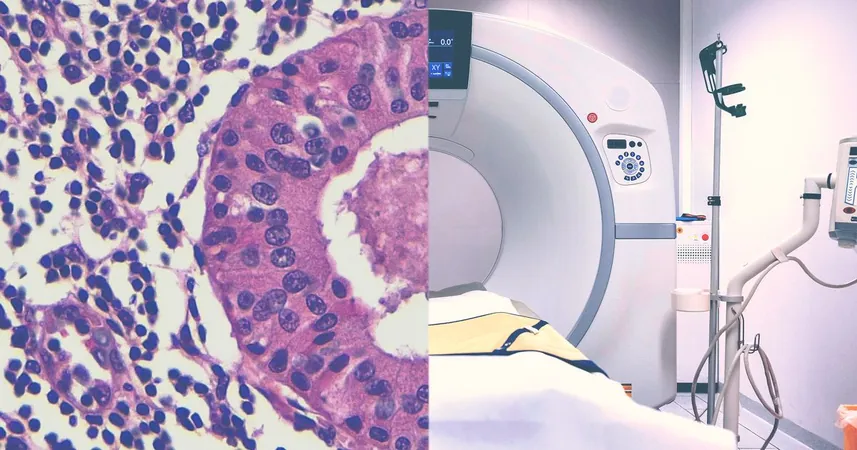
Are CT Scans a Hidden Cancer Risk? Here's What You Need to Know!
2025-04-28
Author: Jia
The Unseen Danger of CT Scans
CT scans are a common tool in modern medicine, used for everything from diagnosing brain injuries in young soccer players to assessing the damage from bike accidents or planning critical surgeries. Patients might even request these scans when they suspect serious issues like lung cancer. However, alarming new research suggests that these life-saving imaging tests could be contributing to a staggering 5% of all new cancer cases each year.
The recent study published in JAMA Internal Medicine highlights that out of approximately 93 million CT scans conducted on 62 million patients in 2023, nearly 103,000 future cancers could be directly linked to these procedures. The risk is particularly pronounced for children and infants, though most expected cancers involve adults—especially in the lungs, colon, blood, bladder, and breast.
CT Scans: The Risks You Need to Know
CT scans utilize ionizing radiation, which is known to damage DNA and increase cancer risk. While it's a crucial diagnostic tool due to its ability to provide detailed imagery, this comes at a cost. Past studies have indicated a link between CT scans and cancer, but the latest research reveals numbers significantly higher than previously reported, showing that frequent and multiphase scans exacerbate risks.
According to Dr. Rebecca Smith-Bindman, an expert from UCSF, we need to reassess our use of CT scans and how we discuss their risks. Patients are encouraged to engage in informed discussions with their healthcare providers regarding the necessity and safety of imaging tests.
When Are CT Scans Necessary?
CT scans are invaluable in urgent and complex situations. They assist in identifying cerebral hemorrhages, assessing internal bleeding from trauma, or diagnosing COVID-19-related lung issues. Furthermore, they help monitor ongoing treatments for cancer and chronic illnesses. Despite alternatives like MRI and ultrasound, CT scans often remain the best option for many conditions.
Who is Most at Risk?
While the risk posed by a single CT scan is low, certain groups are more vulnerable to radiation exposure. For instance, young girls scanned before the age of one may face one cancer diagnosis for every 50 scans. This risk increases for those with specific genetic conditions, such as BRCA mutations or Lynch syndrome, necessitating a much more cautious approach to imaging.
Why Are So Many Unnecessary Scans Ordered?
The increase in CT scans—over 30% since 2007—can be attributed to several factors: busy physicians ordering tests for convenience, the profit motive inherent in medical imaging, and patient demands for reassurance through diagnostics. With many people believing imaging is synonymous with high-quality care, they may overlook the potential risks in their pursuit of comfort.
Navigating the CT Scan Dilemma
Patients advocate for themselves but must do so armed with information. It's essential to ask questions: "Is this scan necessary? Can we consider alternatives?" If a CT scan is essential, patients should also inquire about the lowest possible radiation dose, as discrepancies exist across facilities.
As technology evolves, some centers are committing to safer scanning methods. Programs that standardize radiation doses and improve overall imaging safety are crucial, emphasizing an urgent need for health professionals to reevaluate their practices.
A Call for Informed Choices
CT scans undeniably provide critical medical insights, but awareness of their potential risks is essential. With the knowledge that radiation exposure can lead to future cancer risk, patients must engage actively with their healthcare providers to make informed decisions. By balancing the need for diagnostic clarity with a commitment to minimizing radiation exposure, we can navigate the complexities of modern medicine more safely.
In Conclusion: Balance and Awareness are Key
With rising concerns about carcinogens in our lives, the risks associated with CT scans should not be taken lightly. While these scans are vital in many clinical scenarios, ongoing dialogue between patients and healthcare providers is paramount to ensure that the benefits outweigh the risks. As aware and informed patients, we can advocate for safer practices without compromising on the quality of care.



 Brasil (PT)
Brasil (PT)
 Canada (EN)
Canada (EN)
 Chile (ES)
Chile (ES)
 Česko (CS)
Česko (CS)
 대한민국 (KO)
대한민국 (KO)
 España (ES)
España (ES)
 France (FR)
France (FR)
 Hong Kong (EN)
Hong Kong (EN)
 Italia (IT)
Italia (IT)
 日本 (JA)
日本 (JA)
 Magyarország (HU)
Magyarország (HU)
 Norge (NO)
Norge (NO)
 Polska (PL)
Polska (PL)
 Schweiz (DE)
Schweiz (DE)
 Singapore (EN)
Singapore (EN)
 Sverige (SV)
Sverige (SV)
 Suomi (FI)
Suomi (FI)
 Türkiye (TR)
Türkiye (TR)
 الإمارات العربية المتحدة (AR)
الإمارات العربية المتحدة (AR)